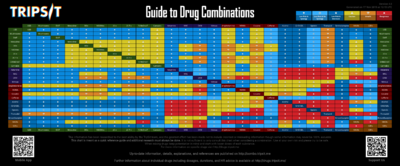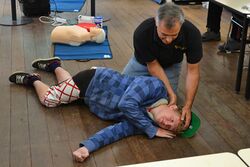Dangerous combinations
This article is a stub. As such, it may contain incomplete or wrong information. You can help by expanding it. |

Although many substances are safe on their own, they can become dangerous and even life-threatening when combined with other substances. Certain combinations may be safe in low doses of each but still increase the potential risk of death. Independent research should always be done to ensure that a combination of two or more substances is safe before consumption.
Substance related deaths most commonly occur when combining depressants. Depressants affect the parts of the nervous system responsible for breathing, and an overdose or combination of these substances can result in fatal levels of respiratory depression. Death may also occur when a victim falls into deep enough unconsciousness to aspirate on their own vomit. Lying in the recovery position can prevent one from suffocating on their own vomit.

Another possibly fatal combination of substances are serotonergic substances, which might cause serotonin syndrome. This can also be caused alone by an overdose of said substances. Serotonin syndrome is a result of excess serotonin in the brain, which can cause seizures, anxiety, tremors, nausea, coma and possibly a deadly fever. Usually this is caused when a user has used an anti-depressant within the last 2 weeks of consuming said substance. These kind of antidepressants include monoamine oxidase inhibitors (MAOIs), serotonin reuptake inhibitors (SSRIs) and serotonin–norepinephrine reuptake inhibitors (SNRI).
Examples
Benzodiazepines
- Depressants (1,4-Butanediol, 2-methyl-2-butanol, alcohol, barbiturates, GHB/GBL, methaqualone, opioids) - This combination can result in dangerous or even fatal levels of respiratory depression. These substances potentiate the muscle relaxation, sedation and amnesia caused by one another and can lead to unexpected loss of consciousness at high doses. There is also an increased risk of vomiting during unconsciousness and death from the resulting suffocation. If nausea or vomiting occurs, users should attempt to fall asleep in the recovery position or have a friend move them into it. It is important to note that this interaction does NOT follow linear pharmacokinetics i.e. the depressant effects from the interaction are multiplicative instead of additive.[citation needed]
- Dissociatives - This combination can result in an increased risk of vomiting during unconsciousness and death from the resulting suffocation. If nausea or vomiting occurs, users should attempt to fall asleep in the recovery position or have a friend move them into it.
- Stimulants - It is dangerous to combine benzodiazepines with stimulants due to the risk of excessive intoxication. Stimulants decrease the sedative effect of benzodiazepines, which is the main factor most people consider when determining their level of intoxication. Once the stimulant wears off, the effects of benzodiazepines will be significantly increased, leading to intensified disinhibition as well as other effects. If combined, one should strictly limit themselves to only dosing a certain amount of benzodiazepines per hour. This combination can also potentially result in severe dehydration if hydration is not monitored.
Opioids
- Depressants (1,4-Butanediol, 2m2b, alcohol, barbiturates, benzodiazepines, GHB/GBL, Ketamine, methaqualone) - This combination can result in dangerous or even fatal levels of respiratory depression. These substances potentiate the muscle relaxation, sedation and amnesia caused by one another and can lead to unexpected loss of consciousness at high doses. There is also an increased risk of vomiting during unconsciousness and death from the resulting suffocation. If nausea or vomiting occurs, users should attempt to fall asleep in the recovery position or have a friend move them into it.
- Dissociatives - This combination can result in an increased risk of vomiting during unconsciousness and death from the resulting suffocation. If nausea or vomiting occurs, users should attempt to fall asleep in the recovery position or have a friend move them into it.
- Stimulants - It is dangerous to combine oxycodone, a depressant, with stimulants due to the risk of excessive intoxication. Stimulants decrease the sedative effect of oxycodone, which is the main factor most people consider when determining their level of intoxication. Once the stimulant wears off, the effects of oxycodone will be significantly increased, leading to intensified disinhibition as well as other effects. If combined, one should strictly limit themselves to only taking a certain amount of oxycodone.
Alcohol
- Depressants (1,4-Butanediol, 2-methyl-2-butanol, barbiturates, benzodiazepines, GHB/GBL, methaqualone, opioids, Ketamine,phenothiazines[1]) - This combination can result in dangerous or even fatal levels of respiratory depression. These substances potentiate the muscle relaxation, sedation and amnesia caused by one another and can lead to unexpected loss of consciousness at high doses. There is also an increased risk of vomiting during unconsciousness and death from the resulting suffocation. If nausea or vomiting occurs, users should attempt to fall asleep in the recovery position or have a friend move them into it.
- Dissociatives - This combination can result in an increased risk of vomiting during unconsciousness and death from the resulting suffocation. If nausea or vomiting occurs, users should attempt to fall asleep in the recovery position or have a friend move them into it.
- Stimulants - It is dangerous to combine alcohol, a depressant, with stimulants due to the risk of excessive intoxication. Stimulants decrease the sedative effect of alcohol, which is the main factor most people consider when determining their level of intoxication. Alcohol also appears to have addictive effects on stimulants compared to taking either of them alone. For instance a study found that concentration d-methylphenidate concentration in the brain are increased by up to 30% when mixed with alcohol. Another study had also found that when there is concurrent administration of methamphetamine (30 mg intravenously) and ethanol (1 gm/kg orally over 30 minutes) increased heart rate by 24 beats/minute compared to methamphetamine alone. Once the stimulant wears off, the effects of alcohol will be significantly increased, leading to intensified disinhibition as well as other effects. If combined, one should strictly limit themselves to only drinking a certain amount of alcohol per hour. This combination can also potentially result in severe dehydration if hydration is not monitored. It also interacts with cocaine in vivo to produce cocaethylene, another psychoactive substance.[2]
- MAOIs - This combination can result in dangerous reactions through the way in which tyramine, a chemical commonly found in alcoholic beverages, causes increased blood pressure.
Psychedelics
NOTE: Because of the relatively high unpredictability of psychedelics, it is usually advised (especially if the person has little or no experience) to avoid mixing them with any other substance, even if the mix is considered physically safe. Even a substance like Alcohol, which tends to dull the psychedelic effects, could trigger a state of confusion which might cause the person to have a negative experience.
- Cannabis - This combination is very unpredictable. Some people like and advise to smoke during a trip to make the experience more relaxing, but in many cases it seems to potentiate the psychedelic effect and/or make the experience more intricate and confusing. This is usually not physically dangerous, but might cause a Bad trip by making the experience too overwhelming and disorienting.
- Stimulants - This combination tends to increase anxiety, thus increasing the possibility of having a negative experience. If the psychedelic substance used is already stimulating on its own (for example a Phenethylamine) a mix like this could cause an increase in heart rate and/or other unpleasant physical and psychological symptoms.
Monoamine oxidase inhibitors (MAOIs), serotonin reuptake inhibitors (SSRIs) and serotonin–norepinephrine reuptake inhibitors (SNRI)
- Empathogens (MDMA) - This combination can result in serotonin syndrome, which is a result of excess amount of the neurotransmitter serotonin in the brain. Symptoms include headaches, agitation, hypomania, confusion, anxiety, hallucinations, coma, shivering, sweating, nausea, twitching and tremors. These symptoms can be fatal.
- Dissociatives (Dextromethorphan) - This combination can result in serotonin syndrome, which is an excess amount of the neurotransmitter serotonin in the brain. Symptoms include headaches, agitation, hypomania, confusion, anxiety, hallucinations, coma, shivering, sweating, nausea, twitching and tremors. These symptoms can be fatal.
- Other antidepressants - This combination can result in serotonin syndrome, which is an excess amount of the neurotransmitter serotonin in the brain. Symptoms include headaches, agitation, hypomania, confusion, anxiety, hallucinations, coma, shivering, sweating, nausea, twitching and tremors. These symptoms can be fatal.
See also
- Responsible drug use
- Recovery position
- Research chemicals
- Drug combination guide and chart (TripSit)
References
- ↑ https://web.archive.org/web/20101214113109/http://my.lecom.edu/library/internetresources/journal%20articles/Acute%20Care%20for%20Alcohol%20Intoxication.pdf
- ↑ Laizure, S. C., Mandrell, T., Gades, N. M., Parker, R. B. (1 January 2003). "Cocaethylene Metabolism and Interaction with Cocaine and Ethanol: Role of Carboxylesterases". Drug Metabolism and Disposition. 31 (1): 16–20. doi:10.1124/dmd.31.1.16. ISSN 0090-9556.